12 Colombian Artists Changing the Face of Contemporary Art
Colombia, a country brimming with creativity and resilience, has long been recognized for its rich cultural heritage and the remarkable talents of its people. Amidst its lush landscapes and vibrant cities lies a deep, complex history, marked by enduring challenges and triumphs. The nation has experienced the gravest internal armed conflict in the Western Hemisphere, a strife that has spanned decades, leaving a profound impact on its social fabric. Today, as Colombia navigates a precarious journey towards peace, it continues to grapple with the lingering shadows of violence and the pervasive issue of corruption. Nevertheless, it is within this very context of adversity that Colombian art and creativity flourish, transforming pain into powerful expressions of resistance, hope, and beauty.
We are going to review 12 outstanding Colombian artists who are leading the way in contemporary art in this article. These people not only bring Colombian art to a worldwide audience, but also reflect the tenacity and complexity of their native country in their creations. They combine storylines of innovation, tradition, and deep reflection through their varied media and distinct viewpoints. Their works serve as a testament to the enduring spirit of a nation, illustrating how art can not only confront and question but also heal and unite.
Join us in celebrating the talent and insight of these artists, who are shaping the future of art, both in Colombia and beyond!
1. Beatriz González
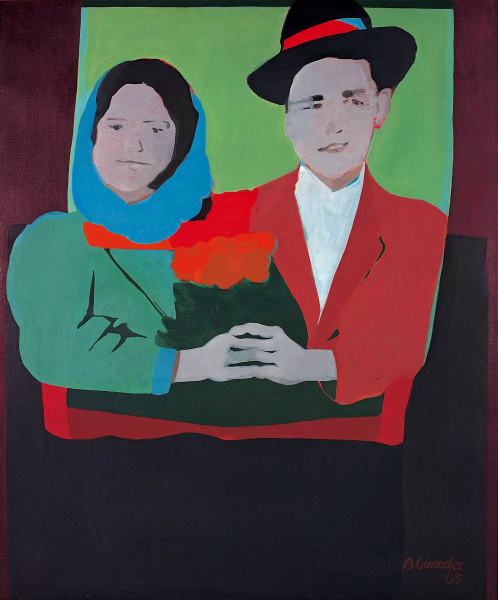
Beatriz González "Los Suicidas Del Sisga" (The Sisga Suicides)
Beatriz González, a significant figure in Latin American contemporary art, was born in Bucaramanga, Colombia, in 1938. She is well-known for her colorful, incisive, and frequently satirical paintings that examine Colombian politics, history, and society. Her art spans painting, drawing, sculpture, and installations, employing a unique blend of pop art aesthetics and socio-political commentary. One of her most renowned works is "Los Suicidas del Sisga" (The Sisga Suicides), a series of paintings based on a newspaper photograph of a couple found dead in their car. González transformed this tragic event into a series of bright, almost cheerful paintings, questioning the way society consumes and forgets such tragedies. This work exemplifies her ability to use color and everyday imagery to engage with complex themes of violence, death, and memory in Colombian society. Another significant piece is "La Coronación" (The Coronation), which reinterprets a classic European coronation scene with figures drawn from Colombian life, encapsulating her critique of the cultural and political colonization of Latin America. Through such works, González deconstructs national narratives and popular icons, making her an outstanding artist for her incisive critique of Colombian identity, history, and the role of art in societal reflection.
2. Doris Salcedo
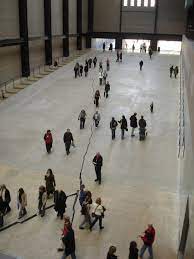
Doris Salcedo "Shibboleth"
Born in Bogotá, Colombia, in 1958, Doris Salcedo is a well recognized and respected artist who is known for her poignant and introspective sculptures and installations that tackle issues of trauma, memory, and the human cost of political violence. One of Salcedo's most famous works is "Shibboleth," a striking installation for the Tate Modern in London, where she created a long crack in the museum's Turbine Hall floor. This monumental work symbolizes borders, the experience of immigrants, and the deep divisions that separate societies and individuals, challenging viewers to confront the unseen and often ignored consequences of colonialism and racism. Salcedo's work is outstanding for its emotional depth, conceptual strength, and meticulous craftsmanship. Through her art, she gives form to grief and loss, making visible the invisible scars left by violence and conflict.
3. Oscar Murillo
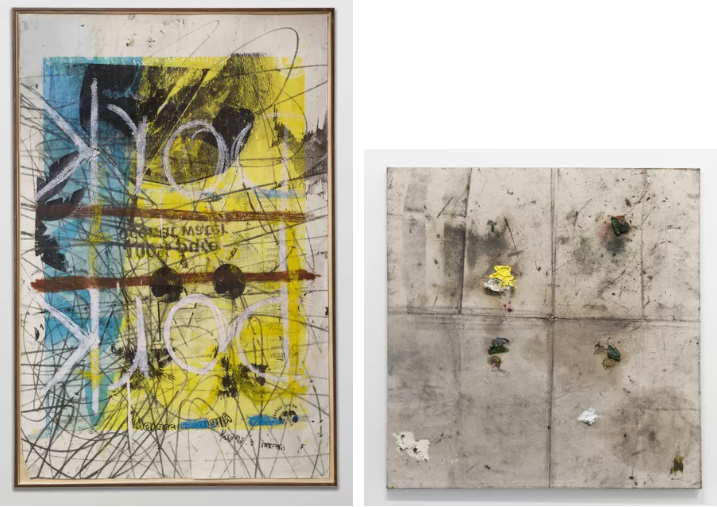
Oscar Murillo
Oscar Murillo, a London-based artist who was born in La Paila, Colombia in 1986, has quickly become an important figure in contemporary art. He is renowned for his dynamic and varied practice, which includes painting, installation, performance, and video. Murillo's work is deeply influenced by his cross-cultural experiences, reflecting on themes of globalization, migration, labor, and the intersection of personal and collective identities. One of his well-known series, "Frequency," showcases his dynamic, gestural paintings that combine abstract and figurative elements, incorporating materials like oil paint, dirt, and debris. Another significant work is "Condiciones aún por titular" (Conditions yet to be titled), an immersive installation that involves participation from local communities, reflecting Murillo's interest in the concept of community, cultural exchange, and the role of art in society. Through activities ranging from communal meals to workshops, Murillo transforms the exhibition space into a site of social interaction and reflection, challenging traditional boundaries between art and life. Oscar Murillo stands out for his ability to weave together the personal and the political, creating works that resonate with the complexities of contemporary life.
4. Abel Rodríguez
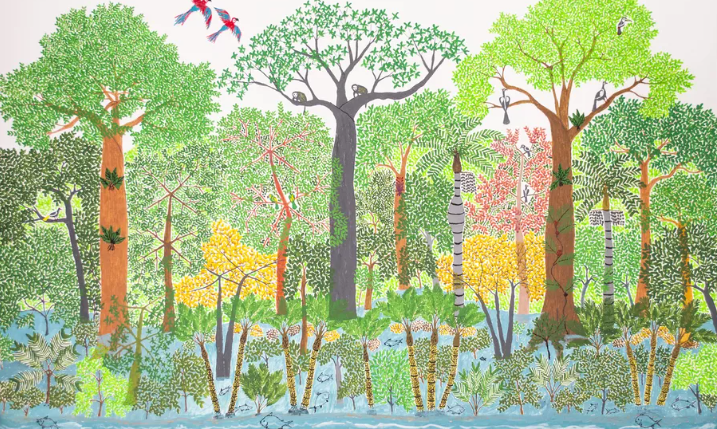
Abel Rodríguez, Aycoobo Terraza Inundable, 2018
Abel Rodríguez, an elder of the Nonuya people, an indigenous group from the Colombian Amazon, is a unique artist who brings the rich oral traditions and deep ecological knowledge of his culture to life through his intricate drawings and paintings. His work is a testament to the profound relationship between the indigenous peoples of the Amazon and their natural environment, depicting the flora and fauna of the rainforest with remarkable detail and accuracy. One of his most celebrated works is "Neejí B?'j? Yeé" (The Great Transformation), a series of drawings that illustrate the cosmology and natural wisdom of the Nonuya people. Through these works, Rodríguez shares the ancestral knowledge passed down to him by his uncle, a traditional sage, offering a window into the complex ecosystem of the Amazon rainforest and the spiritual beliefs that guide the Nonuya's interaction with their environment. Another significant piece by Rodríguez is his detailed botanical drawings, which serve both as artistic expressions and as scientific documents, cataloguing the diverse plant species of the Amazon. Rodríguez's work is outstanding for its ability to capture the essence of the Amazon's life through the eyes of someone deeply connected to its land and traditions, making him a vital contemporary artist and an important cultural ambassador for his people.
5. María José Arjona

María José Arjona
Right At The Center There Is Silence, 2011
"Auto Body" At Faena Art Center, Buenos Aires (2015)
María José Arjona is a Colombian performance artist known for her physically demanding and conceptually challenging performances, which explore the limits of the body and the dynamics of human endurance. Her work often addresses themes of time, memory, and the physical and psychological constraints imposed by society and by our own limitations. One of her notable works is "Longitudinal de Occidente," a performance in which Arjona walked continuously for several hours along a predetermined path, exploring the concepts of movement, persistence, and the passage of time. This performance is emblematic of her interest in testing the limits of physical endurance and the body's relationship to space. Another significant piece is "Second Skin," where Arjona wrapped herself in layers of different materials, challenging the notion of identity and the external factors that shape and constrain our beings. This work delves into themes of transformation, vulnerability, and the construction of the self, showcasing Arjona's ability to use her body as a powerful medium for expression and critique.
6. María Berrío

Maria Berrio - The Dream Of Flight, 2019
Based in Brooklyn, New York, María Berrío is a Colombian artist whose precise detail and ethereal, dreamlike aspect set her work apart. Utilizing a unique technique that involves layering Japanese rice paper to create textured, collage-like compositions, Berrío crafts vivid, large-scale pieces that explore themes of femininity, displacement, and resilience. One of her most captivating works, "A Cloud's Roots," features a surreal landscape inhabited by women and animals, all rendered in a soft, pastel palette that evokes a sense of otherworldly tranquility. This piece reflects Berrío's interest in storytelling and her ability to weave together elements of mythology, personal memory, and cultural heritage into a cohesive visual narrative. Another significant piece by Berrío is "The Lovers," which depicts two figures entwined in a lush, floral environment, symbolizing the connection between humans and nature. María Berrío's work is outstanding for its unique combination of traditional and contemporary techniques, its rich symbolism, and its profound exploration of themes related to identity, migration, and the human condition.
7. Gabriel Sierra
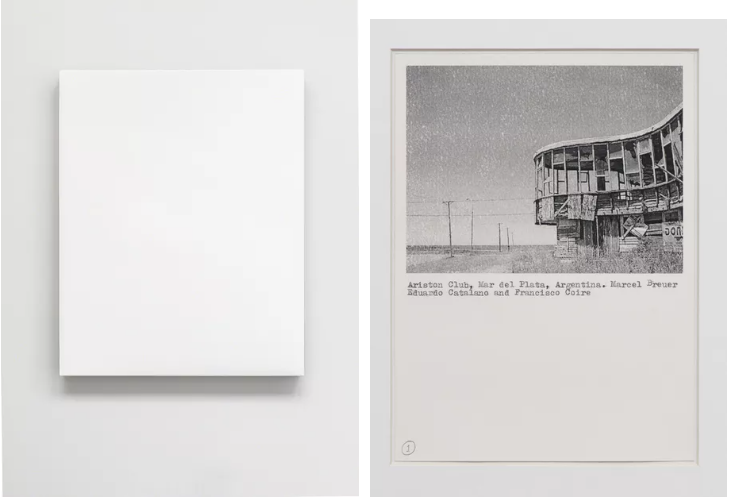
Gabriel Sierra "Untitled (Monday Through Sunday)"
Gabriel Sierra, born in 1975 in San Juan Nepomuceno, Colombia, is a contemporary artist whose work ingeniously intersects the realms of architecture, design, and sculpture. Sierra's art is characterized by its playful yet profound exploration of space and perception, often transforming ordinary environments into extraordinary experiences through subtle modifications and interventions. One of his most acclaimed installations, "Untitled (Monday through Sunday)," presented at the Renaissance Society in Chicago, showcases Sierra's capacity to alter perceptions of space and time. In this work, he reconfigured the gallery space to reflect different days of the week, using architectural modifications and temporal references to engage with the viewer's sense of routine and dislocation. Sierra's outstanding contribution to contemporary art lies in his innovative approach to the spatial and the mundane, inviting viewers to reconsider their everyday surroundings and the ways in which they interact with space.
8. Karen Paulina Biswell
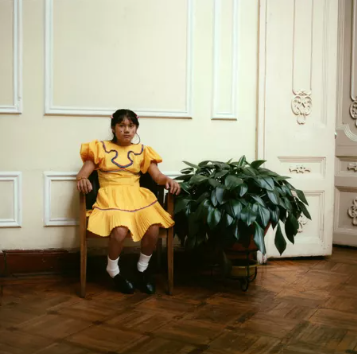
Karen Paulina Biswell Achiba Dai Una Panuma (They See Us), 2013
Karen Paulina Biswell, a photographer of Colombian and Emberá descent, has carved a unique niche in contemporary art with her compelling and often provocative visual narratives. Born in 1983, Biswell's work is deeply influenced by her multicultural background, exploring themes of identity, marginalization, and the human condition. Her photography stands out for its raw, unfiltered portrayal of her subjects, often focusing on indigenous communities, women, and the underrepresented in society. One of her most recognized works is "Niños" (Children), a powerful series that captures the innocence and vulnerability of children in various socio-cultural contexts. This series, among others, showcases Biswell's ability to connect with her subjects on a profound level, creating images that are both haunting and deeply moving. Another notable work by Karen Paulina Biswell is "Eagle Women," a striking photographic series that delves into the lives and spirits of women from indigenous cultures, portraying them with an almost ethereal majesty. These images capture the strength, dignity, and profound connection these women have with their ancestral roots and the natural world, showcasing Biswell's unique ability to convey complex narratives through powerful visual imagery.
9. José Antonio Suárez Londoño

José Antonio Suárez Londoño Dibujo, 1994 Galleria Continua
José Antonio Suárez Londoño, born in 1955 in Medellín, Colombia, is an artist celebrated for his intricate and detailed works on paper, including drawings and engravings that encompass a wide range of subjects from personal diaries to literary and historical references. His practice is marked by a daily discipline of drawing, creating a vast body of work that serves as a visual journal of his life and thoughts. One of his most notable projects is "El Año" (The Year), a series where he created a drawing for each day of the year, blending elements of autobiography with cultural and botanical imagery. This project highlights his exceptional skill in detail and his capacity to find the universal in the personal, making the everyday profound. Another notable work by José Antonio Suárez Londoño is "El Calendario de las Aves" (The Calendar of Birds), a series of prints that intricately depicts different bird species for each day of the year. This work combines his passion for the natural world with his meticulous attention to detail, showcasing his ability to blend scientific observation with artistic expression.
10. Oscar Muñoz

Oscar Muñoz Ludovico’s Method, 2018
Oscar Muñoz, born in 1951 in Popayán, Colombia, is a visual artist renowned for his innovative exploration of memory, impermanence, and the ephemeral nature of human existence. Muñoz's work transcends traditional mediums, employing a mix of photography, video, sculpture, and installation to investigate the fluid relationship between the image and the reality it represents. One of his most acclaimed works, "Aliento" (Breath), exemplifies his mastery in capturing the fleeting moments of life. In this series, Muñoz presents mirrors etched with portraits that only become visible when the viewer breathes on them, symbolizing the transient nature of human life and memory. Another significant work by Oscar Muñoz is "Proyecto para un Memorial" (Project for a Memorial), an evocative video installation that captures images of faces being drawn with water on hot pavement, only to evaporate moments later. This powerful piece continues Muñoz's exploration of memory and loss, poignantly reflecting on the ephemeral nature of existence and the way memories fade over time, despite our efforts to preserve them.
11. Debora Arango

Debora Arango "Las Monjas" (The Nuns)
Debora Arango, originally active in the mid-20th century, remains a seminal figure in Colombian contemporary art for her bold and pioneering contributions. As a trailblazer, she challenged the conservative norms of her time with provocative and politically charged works, paving the way for future generations of artists. Arango's art often depicted social and political injustices, daringly addressing themes such as corruption, violence, and the roles of women in society. One of her most famous works, "Las Monjas" (The Nuns), stands out for its critical portrayal of the Catholic Church, a subject that was considered taboo and sparked controversy during her career. This piece exemplifies her fearless approach to social commentary, employing expressionist techniques to capture the complexities of Colombian society. Arango's outstanding contribution lies in her unapologetic use of art as a medium for social critique, making her a pivotal figure in the evolution of contemporary art in Colombia and a symbol of artistic resilience and integrity.
12. Carlos Jacanamijoy
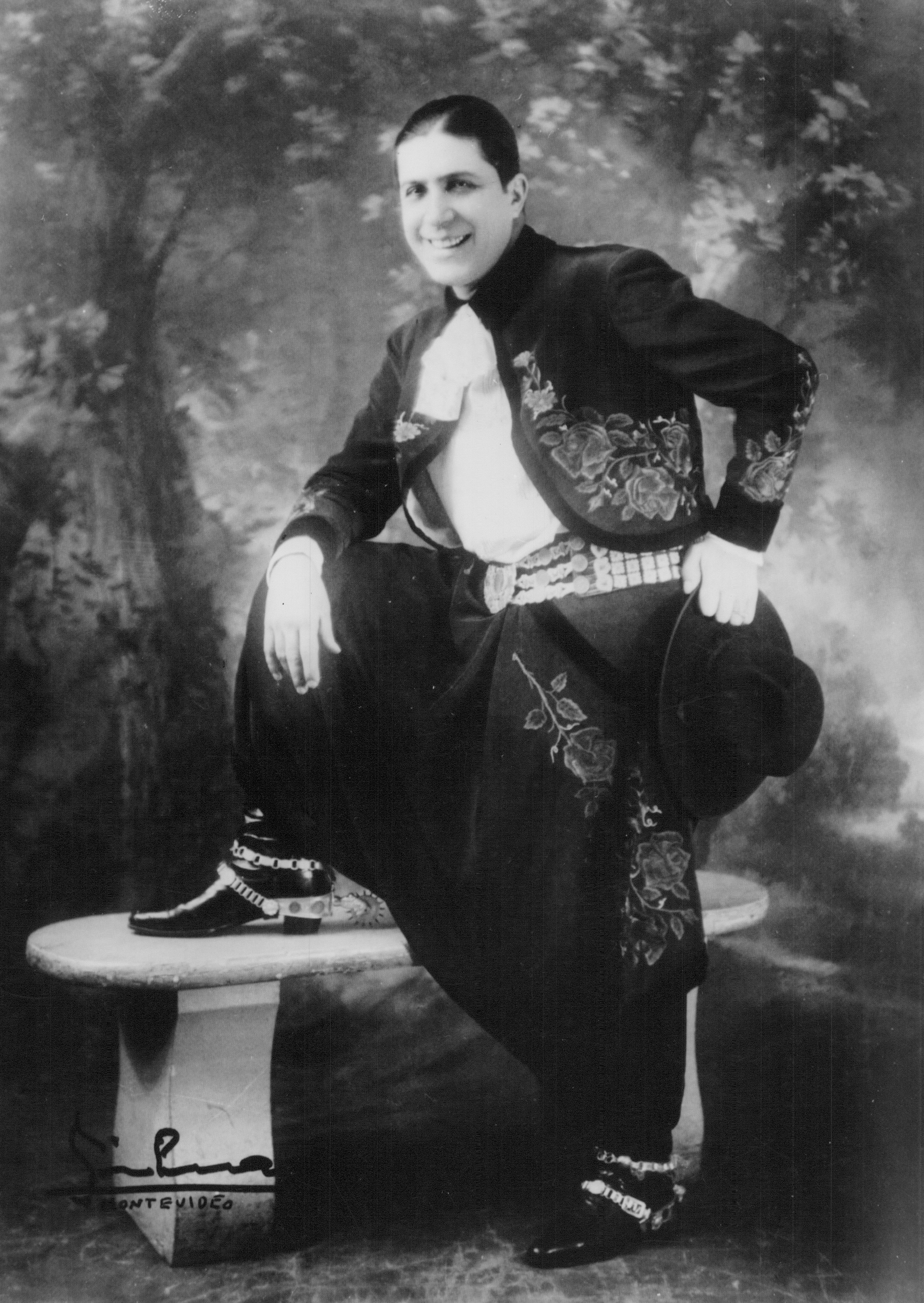
Carlos Jacanamijoy
Carlos Jacanamijoy, a distinguished Colombian painter, draws profound inspiration from his indigenous roots, specifically his Inga heritage. Born in 1964 in the Putumayo region, a place deeply connected to the Amazon rainforest, Jacanamijoy's work is a vivid exploration of identity, nature, and the spiritual. His paintings are celebrated for their dynamic use of color and light, creating immersive landscapes that seem both fantastical and deeply rooted in the natural world. One of his most notable works, "Lluvia" (Rain), encapsulates his ability to blend the abstract with the figurative, portraying the rainforest not just as a physical space but as a living, breathing entity full of mystery and spirituality. Carlos Jacanamijoy stands out for his unique ability to bridge worlds – the ancestral and the contemporary, the indigenous and the global. His work offers a poignant reflection on the importance of nature, heritage, and cultural memory, making him a significant figure in both Colombian and international art circles.
No Comments Yet...